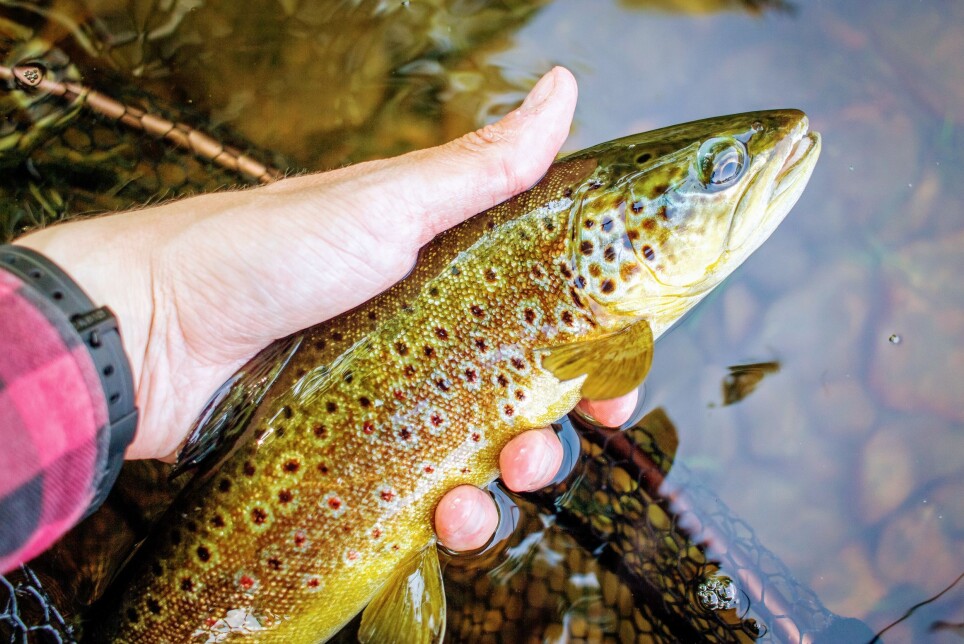THIS ARTICLE/PRESS RELEASE IS PAID FOR AND PRESENTED BY the Institute of Marine Research - read more

Why freshwater fish sometimes taste earthy
… and why this creates a challenge for land-based fish farming.
Anyone who has cooked a trout caught in a small forest lake may be familiar with the problem: it tastes earthy.
“The distinctive earthy taste is caused by geosmin, a substance produced by many bacteria,” explains Erik-Jan Lock, a researcher at the Institute of Marine Research.
“These bacteria are found almost everywhere, but conditions are particularly good for them in stagnant waters,” he says.
Familiar aroma
You will know the smell of geosmin from dried up riverbeds, the forest floor in spring and when you dig up a flower bed. Some people find it nostalgic and pleasant. It is only when food tastes of geosmin that many people scrunch up their noses.
“It takes very little. Our noses are extremely sensitive to geosmin. In fish it tends to settle in the skin and fat. But it is harmless, both to the fish and to the people who eat it,” says Lock.
According to him, geosmin may also be an acquired taste, like coffee, beer or cured meat.
Some people miss the earthy taste
“As with other tastes, there’s a cultural element as to whether or not you like it. People from the interior of China and India, who are used to eating carp fish kept in ponds, expect fish to have this taste. They may think that something fundamental is missing when they taste ‘insipid’ Norwegian seafood,” he says.
Maybe you like beetroot. It has a distinct taste of geosmin - but there you expect it. In the market for salmon, on the other hand, the taste is unwanted.
Geosmin therefore creates a challenge for land-based fish farms, or so-called RAS facilities.
The bacteria thrive in land-based fish farms
“That is because you have a closed system where the water is recirculated. In order to reuse the water, you have to filter it of remains of feed and fish faeces,” says Lock.
To do this, fish farmers typically use biofilters – 'friendly' bacteria that break down the waste materials. The bacteria that produce geosmin thrive alongside them.
“Currently, the main method used to eliminate the earthy taste is to fast the fish in fresh water before they are slaughtered. So called purging,” says Lock.

Eliminates the earthy taste, but also some of the fish?
It is normal to leave salmon for several days without feeding them before they are slaughtered. This empties their digestive system and makes them better suited to cope with stress. But in order to eliminate the earthy taste at RAS facilities, the salmon need to fast for longer – often up to two weeks. In theory, fasting fish can cause them to lose some weight, or to miss out on potential weight gain from feeding.
“However, salmon are very flexible. Research at the IMR shows that fasting is unlikely to have a noticeable impact on the harvest weight of salmon. It may affect their fat content, but only on paper,” says Lock.
“The real challenge, both from a practical and financial point of view, is the logistics of putting the fish in fresh water,” say Lock.
Complex logistical operation
Fish farmers have to either transfer tonnes of fish to empty tanks as gently as possible, or replace tonnes of water. The facility has to be designed for this, and it requires large quantities of water to be on hand. The water may also need to be treated or heated.
“FIsh farmers who produce fish for consumption at RAS facilities no doubt have good solutions and procedures for removing the earthy taste. But they would prefer there to be simpler methods available,” says Lock.
———
Read the Norwegian version of this article at forskning.no
See more content from the Institute of Marine Research:
-
These whales have summer jobs as ocean fertilisers
-
Have researchers found the world’s first bamboo coral reef?
-
Herring suffered collective memory loss and forgot about their spawning ground
-
Researchers found 1,580 different bacteria in Bergen's sewage. They are all resistant to antibiotics
-
For the first time, marine researchers have remotely controlled an unmanned vessel from the control room in Bergen
-
New discovery: Cod can adjust to climate change – from one generation to the next





































